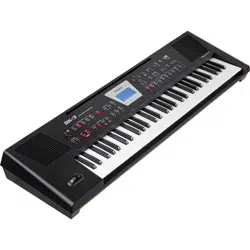Loading ...
Loading ...
Loading ...

Menu options
46
Characteristics of a low-pass lter
Setting
Frequency
Cuto frequency
NOTE
For some sounds, positive (+) Cuto settings will cause no
noticeable change because the pre-programmed Cuto
parameter is already set to its maximum value
Parameter Setting
Cut O –64~+63
Resonance
When the Resonance value is increased, the overtones in the area
of the cuto frequency will be emphasized, creating a sound with a
strong character.
Parameter Setting
Resonance –64~+63
NOTE
For some sounds, negative (–) “Resonance” settings may
produce no noticeable change because the Resonance is
already set to the minimum value.
Attack (only for Tones)
This parameter adjusts the onset of the sound. Negative values
speed up the attack, so that the sound becomes more aggressive.
Parameter Setting
Attack –64~+63
Decay
This parameter adjusts the time over which the sound’s volume and
cuto frequency fall from the highest point of the attack down to
the sustain level.
Parameter Setting
Decay –64~+63
NOTE
Percussive sounds usually have a sustain level of “0”. Piano and
guitar sounds are in this category. Holding the keys for a long
time will have little eect on the duration of the notes you are
playing, even if you select a high value here
Release
This parameter adjusts the time over which the sound will decay
after the note is released until it is no longer heard. The cuto
frequency will also fall according to this setting.
Parameter Setting
Release –64~+63
Vibrato Rate
This parameter adjusts the speed of the pitch modulation. Positive
(+) settings make the preset pitch modulation faster and negative
(–) settings make it slower.
Parameter Setting
Vibrato Rate –64~+63
Vibrato Depth
This parameter adjusts the intensity of the pitch modulation.
Positive (+) settings mean that the “wobble” becomes more
prominent, while negative (–) settings make it shallower.
Parameter Setting
Vibrato Depth –64~+63
Vibrato Delay
This parameter adjusts the time required for the vibrato eect to
begin. Positive (+) settings increase the time before vibrato will
begin and negative settings shorten the time
Parameter Setting
Vibrato Delay –64~+63
C1
The function of this parameter depends on the sound you assigned
to the selected part. It may inuence the lter and resonance
setting, switch between the organ samples with the fast and slow
Rotary modulation, etc.
Parameter Setting
C1 0~127
‘Tone Part Mfx’ parameters
This function group can be selected using [MENU] button “Performance
Edit” “Tone Part Mfx”. Your BK-3 contains a multi-eects processor that
can be used for processing any keyboard part you like. See “Mfx” (p. 45).
(There are also 2 Mfx processors for the rhythm/ song parts).
Mfx Switch
Select “O” if you don’t need the Mfx processor.
Parameter Setting
Mfx Switch O, On
Mfx Type
The BK-3 provides 84 dierent multi-eect types, some of which
are combinations of two eects for added exibility. This parameter
allows you to select the desired type. The available types are:
N. Mfx Type N. Mfx Type N. Mfx Type
1 Thru 29
0OD Delay
57 VK Rotary
2 Stereo EQ 30
DST Chorus
58 3D Chorus
3 Overdrive 31
DST Flanger
59 3D Flanger
4 Distortion 32
DST Delay
60 3D Step Flgr
5 Phaser 33
EH Chorus
61 Band Chorus
6 Spectrum 34
EH Flanger
62 Band Flanger
7 Enhancer 35
EH Delay
63 Band Step Flg
8 Auto Wah 36.
ChorusDLY
64 VS Overdrive
9 Rotary 37
Flanger DLY
65 VS Distortion
10 Compressor 38
CHO Flanger
66 GT Amp Simul
11 Limiter 39 CHO/DLY 67 Gate
12 Hexa-Chorus 40 Flanger/DLY 68 Long Delay
13 Trem Chorus 41 CHO/Flange 69 Serial Delay
14 Space-D 42 Isolator 70 MLT Tap DLY
15 St. Chorus 43 Low Boost 71 Reverse DLY
16. St. Flanger 44 Super Filter 72 Shue DLY
17 Step Flanger 45 Step Filter 73 3D Delay
18 St. Delay 46 Humanizer 74 Long DLY
Loading ...
Loading ...
Loading ...
